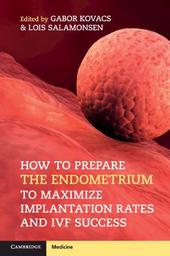
|
How to Prepare the Endometrium to Maximize Implantation Rates and IVF Success
Paperback / softback
Main Details
| Title |
How to Prepare the Endometrium to Maximize Implantation Rates and IVF Success
|
| Authors and Contributors |
Edited by Gabor Kovacs
|
|
Edited by Lois Salamonsen
|
| Physical Properties |
| Format:Paperback / softback | | Pages:212 | | Dimensions(mm): Height 234,Width 155 |
|
| ISBN/Barcode |
9781108402811
|
| Classifications | Dewey:618.1780599 |
|---|
| Audience | | Professional & Vocational | |
|---|
| Illustrations |
Worked examples or Exercises
|
|
Publishing Details |
| Publisher |
Cambridge University Press
|
| Imprint |
Cambridge University Press
|
| Publication Date |
17 January 2019 |
| Publication Country |
United Kingdom
|
Description
The last step in the IVF treatment cycle, embryo transfer, is also the process with the highest failure rate. No matter how good the laboratory technique is, a successful pregnancy will not be achieved without meticulous preparation of the uterus to accept the embryo. This book reviews the scientific evidence on endometrial receptivity, including histological, hormonal, biochemical, and immunological factors. Practical and concise, it supports gynecologists and embryologists to make evidence-based decisions that can influence the success rates of implantation and live births. Part of a series of books offering treatments and strategies for fertility and conception to optimize IVF outcomes, this volume is for all clinicians and embryologists working in reproductive medicine.
Author Biography
Gabor Kovacs is Professor in the Department of Obstetrics and Gynaecology at Monash University, Victoria. A Reproductive Gynecologist, he has forty years of experience in the treatment of subfertility including IVF, donor insemination, ovulation induction and reproductive surgery. He has a passion for teaching and has edited fourteen books for Cambridge University Press. Lois Salamonsen is Professor at the Centre for Reproductive Health, Hudson Institute of Medical Research, and Department of Molecular Biosciences, Monash University, Victoria. She was elected Fellow of the Australian Academy of Sciences and Honorary Fellow of the Royal Australasian College of Obstetrics and Gynaecology in recognition of her contribution to women's health research. For thirty years, her research has focussed on the molecular events underpinning human endometrial function.
|